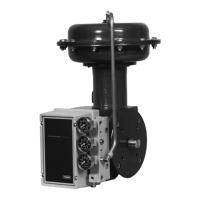Type 1051 & 1052 Styles H & J
13
Table 6. Wrench Sizes Required for Turnbuckle
Adjustment, Inches
ACTUATOR
TURN-
LOWER
UPPER
Type Size
BUCKLE
(KEY 57)
LOCKNUT
(KEY 16)
LOCKNUT
(KEY 58)
1051 &
1052
30
40
60
15/16
1-1/8
1-5/16
1/2
3/4
15/16
7/8
1-1/8
1-5/16
1052 70 1-5/16 1-1/8 1-5/16
For accurate adjustment, remove the valve body or
other operated equipment from the pipeline.
A regulated air supply will be required to stroke the
actuator. Consult table 6 for the sizes of the three
openend wrenches required for this procedure.
1. Remove the access plate (key 59). Also remove
the machine screws (key 60), if present.
Note
For the most accurate adjustment of the
actuator, do not remove the cover (key
33) during this procedure.
2. Loosen the lower Locknut (key 16).
3. Make sure the actuator housing (key 20) is clear of
any tools or other instruments that could obstruct the
actuator stroke path. Pressure the diaphragm casing
enough to stroke the actuator down so that the left-
hand threaded upper locknut (key 58) is accessible
through the access opening. Loosen the locknut.
4. Use one of the following:
a. For push-down-to-close action—Slowly stroke
the actuator to the down travel stop. Consult the
appropriate instruction manual for determining the
closed position of the valve body or other operated
equipment. Adjust the turnbuckle (key 57) until the
closed position is reached. Lock this adjustment
with the left-hand threaded locknut (key 58). Stroke
the actuator to the mid-travel position, and tighten
the locknut (key 16). Tighten each locknut to the
appropriate torque value listed in table 7.
b. For push-down-to-open action—Consult the ap-
propriate instruction manual for determining the
closed position of the valve or other operated
equipment. Release all pressure from the dia-
phragm casing, making sure the diaphragm is
against its up travel stop. Be sure that the optional
handwheel is adjusted to its topmost position so
that the closed position of the actuator and valve
body or other operated equipment can be reached
simultaneously. Check the position of the valve
body or other operated equipment with respect to
its properly closed position. Stroke the actuator so
the turnbuckle (key 57) is accessible through the
Table
7. Recommended Bolting T
orques
KEY
ACTUATOR SIZE
NUM-
30 40 60 70
BER
ftDlbf NDm ftDlbf NDm ftDlbf NDm ftDlbf NDm
6 15 20 15 20 15 20 15 20
7 & 8 30 41 30 41 30 41 75 102
9 25 34 25 34 75 102 75 102
16 10 14 25 34 45 61 75 102
18 16 22 60 81 120 163 200 271
21 7 9 7 9 16 22 50 68
23 25 34 25 34 60 81 60 81
28 25 34 60 81 120 163 200 271
34 25 34 25 34 60 81 60 81
40 7 9 7 9 7 9 7 9
54
(hand-
wheel)
25 34 25 34 25 34 25 34
54
(hand-
wheel)
15 20 20 27 49 66 51 69
58 35 47 75 102 120 163 120 163
141 30 41 30 41 30 41 30 41
access opening. Adjust the linkage. Release pressure
to the actuator, and check the new adjustment. Contin-
ue this procedure until the operated equipment is in
the closed position when the actuator is resting on its
up travel stop. Tighten locknut (key 16). Stroke the
actuator, and tighten left-hand threaded locknut (key
58). Tighten each locknut to the appropriate torque
value listed in table 7.
5. Replace the access plate (key 59). Also, replace
the machine screws (key 60), if present.
6. Loosen the self-tapping screws (key 38), and ad-
just the travel indicator (key 37). Retighten the self-
tapping screws.
Type 1052 Spring Adjustment
Initial Compression
The Type 1052 nameplate (figure 3) specifies a spring
set, which is the initial compression adjusted into the
actuator spring, Initial compression is the casing pres-
sure at which the diaphragm and diaphragm rod begin
to move away from the up travel stop with the actuator
disconnected from the valve body or other operated
equipment. (With the actuator connected and pressure
applied to the valve body or other operated equipment,
a higher casing pressure will be required to start ac-
tuator travel). The initial compression was selected
(based upon the service conditions specified when the
actuator was ordered) so that when the actuator and
valve body or other operated equipment are in service,
the operated equipment will close properly and full
travel will be obtained within a diaphragm casing pres-
sure range of 0 to 18,0 to 33,0 to 40, or 0 to 55 psig (0
to 1.2, 0 to 2.3,0 to 2.8 or 0 to 3.8 bar) depending on
specific actuator size and construction.

